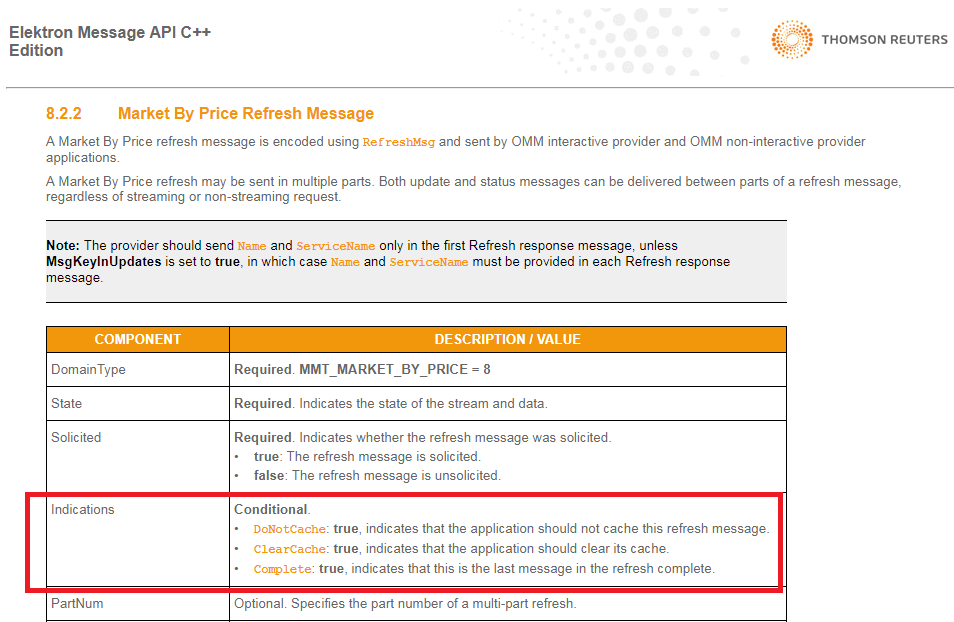I try to find out how to handle refresh messages in Market By Price (level 2) data. I was told by the support help desk that there are refresh messages on which we should clear the whole cache (our constructed order book) and refresh messages which do not. How are we suppose to distinguish these two types of refresh messages?
For example in the underlying TRTHv2 data snippet we took from DataScope, if we would clear our cache and order book on the refresh message then in the subsequent update we have to update an order which does not exist anymore:
7203.T,Market By Price,2018-01-15T01:06:37.281977617Z,+9,Raw,REFRESH,,,,,4742,0,58927,0
,,,,Summary,,,,,,,,,20
,,,,FID,1,,PROD_PERM,4742,
,,,,FID,3,,DSPLY_NAME,TOYOTA MOTOR CO,
,,,,FID,15,,CURRENCY,392,JPY
,,,,FID,17,,ACTIV_DATE,2018-01-15,
,,,,FID,259,,RECORDTYPE,113,
,,,,FID,1080,,PREF_DISP,0,
,,,,FID,1709,,RDN_EXCHD2,106,TYO
,,,,FID,3422,,PROV_SYMB,7203,
,,,,FID,3423,,PR_RNK_RUL,1,NOR
,,,,FID,3425,,OR_RNK_RUL,2,"PTS "
,,,,FID,3694,,MNEMONIC,7203,
,,,,FID,4148,,TIMACT_MS,3996735,
,,,,FID,5357,,CONTEXT_ID,2125,
,,,,FID,6401,,DDS_DSO_ID,4098,
,,,,FID,6480,,SPS_SP_RIC,.[SPSTFFL2,
,,,,FID,6516,,BOOK_STATE,3,X
,,,,FID,6517,,HALT_REASN," ",
,,,,FID,6519,,MKT_OR_RUL,1,I
,,,,FID,6614,,TRD_STATUS,1,"N "
,,,,FID,14269,,TIMACT_NS,01:06:36.735317000,
7203.T,Market By Price,2018-01-15T01:06:38.298915012Z,+9,Raw,UPDATE,UNSPECIFIED,,,,4742,,58928,0
,,,,Summary,,,,,,,,,6
,,,,FID,17,,ACTIV_DATE,2018-01-15,
,,,,FID,4148,,TIMACT_MS,3998230,
,,,,FID,6516,,BOOK_STATE,3,X
,,,,FID,6517,,HALT_REASN," ",
,,,,FID,6614,,TRD_STATUS,1,"N "
,,,,FID,14269,,TIMACT_NS,01:06:38.230599000,
,,,,MapEntry,,UPDATE,,,,,,76530000A,8 <===========FAULTY UPDATE
,,,,FID,3427,,ORDER_PRC,7653,
,,,,FID,3428,,ORDER_SIDE,2,ASK
,,,,FID,4356,,ACC_SIZE,1500,
,,,,FID,3430,,NO_ORD,12,
,,,,FID,6527,,LV_TIM_MS,3998230,
,,,,FID,6529,,LV_DATE,2018-01-15,
,,,,FID,3886,,ORDER_TONE," ",
,,,,FID,14268,,LV_TIM_NS,01:06:38.230599000,





